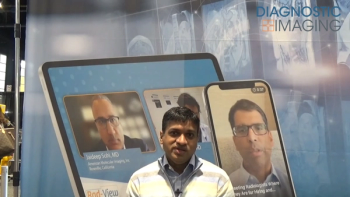
New detectors and shielding improve radiologists' safety
Two trends could potentially put interventional radiologists at greater risk of radiation exposure: the overall increase in image-guided procedures and a rise in the number of obese patients being treated.
Two trends could potentially put interventional radiologists at greater risk of radiation exposure: the overall increase in image-guided procedures and a rise in the number of obese patients being treated.
In normal-sized patients, the benefits of interventional radiology procedures generally outweigh the radiation risks. Obese patients, however, require a longer time in the fluoroscopy suite, subjecting interventionalists to longer exposure.
"It's more difficult to see the anatomy, and the procedure generally takes longer," said Carol McGee, a radiologist technologist at St. Luke's Hospital in Bethlehem, PA.
Research is ongoing to reduce radiation exposure in the interventional suite. Two studies presented at the 2005 Society of Interventional Radiology meeting found that flat-panel x-ray detectors and new radiation shields made of composite materials significantly reduced IRs' exposure to radiation.
McGee and colleagues at St. Luke's compared a conventional image-intensifier fluoroscopy system with a digital flat-panel angiography system on 44 random patients undergoing abdominal aortograms and inferior vena cava filter placements. The digital system reduced operator radiation exposure by as much as 54%.
The flat-panel system delivered 0.49 mrem of radiation dose, compared with 1.07 mrem for the conventional image intensifier. The flat-panel system also delivered better quality images (6 versus 5 on a 7-point Leikert scale), while using less contrast agent (213 mgI/mL versus 240 mgI/mL). The differences were statistically significant, McGee said.
The next step is to analyze the amount of radiation absorbed by the patient. Researchers have installed Diamentors in each fluoro room. Unlike dosimeters, these dose-measuring devices are hardwired into the machinery. McGee expects the flat-panel system to deliver less dose.
"The trend will be to gradually replace the conventional technology with flat-panel systems," she said.
In another study, Gary D. Hartwell, D.Sc., an assistant professor of radiology, and colleagues at the University of Virginia Health System evaluated the ability of lead-equivalent shielding material to reduce scatter radiation during interventional procedures. The investigators used an anthropomorphic phantom and a fluoro C-arm configured with its x-ray tube under the angiography table. They gauged exposure with a dosimeter at different body levels and C-arm positions. The exposure levels were measured in mrem/second at 30 degrees with and without shields, respectively:
- 2.1 versus 15.6 to the eye;
- 2.9 versus 20 to the chest;
- 3.1 versus 26.4 to the waist; and
- 2.9 versus 30.2 to the knee.
Composite shields used appropriately could reduce radiation exposure by more than 80%, he said.
Newsletter
Stay at the forefront of radiology with the Diagnostic Imaging newsletter, delivering the latest news, clinical insights, and imaging advancements for today’s radiologists.



























